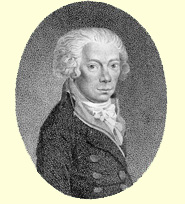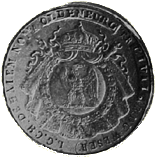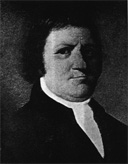Some persons are mentioned more often in the history of the V.Halem family, because they were 'famous'
in the history of their region or country. On this page you will find some of those 'very important persons (VIP's)'
Gerard Anton von Halem (1752-1819)  can be seen as the 'well-known Von Halem' of his days.
He belonged to the bureaucracy of Oldenburg and to the well-educated people of Oldenburg, and
was a member of the lawyer-family Von Halem. His curriculum is quite impressive:
can be seen as the 'well-known Von Halem' of his days.
He belonged to the bureaucracy of Oldenburg and to the well-educated people of Oldenburg, and
was a member of the lawyer-family Von Halem. His curriculum is quite impressive:
As a young man he studied in the large cities of Frankfurt and Strassburg, afterwards he was promoted in Kopenhagen in 1770 and worked as a lawyer in Oldenburg.
He worked at a court of justice ('Landesgericht') as an assessor in the year of 1775. In 1780 he worked at the Council of the government of Oldenburg and at the Chancellery of Justice
('Justizkanzlerei'). In 1806 he became head of the 'Justizkanzlerei' and of the 'Konsistorium' of Oldenburg. In 1813 he finally became First Member of
the government in Eutin.
Gerard Anton von Halem was known as a poet, a writer, a worker at the "Teutschen Merkur" and at the "Deutschen Museum", and
also as a publisher of magazines (the magazine 'Blätter vermischten Inhalts').
Other important dates in his life are: 1776: entering the lodge "Zum goldenen Hirsch" of Oldenburg; 1777: lawyer, 1777–83: second superintendent;
1783–85: Deput. Meister; 1785–90: lawyer 'vom Stuhl' (Meister vom Stuhl).
Gerard Anton von Halem wrote a literary work, mainly about the european literature of the 18th centry, out of 8000 book-parts. He was a playwright and a writer about voyages in the days of the Revolution. He wrote
e.g about his trip to Paris in 1790. Also his history book of Oostburg ('Geschichte des Herzogthums Oldenburg') is quite impressive. (Source: Picture G.A. von Halem; Painting: Johann David Laurens d.J, 1802; 4; 5; 7)
The literature works of G.A. von Halem: 'Wallenstein, ein Schauspeil'(1786); 'Poesie und Prose'(1789); 'Blicke auf einen Theil
Deutschlands...'(1791); 'Andenken an Oeder'(1792); 'Dramatische Werke'(1794); 'Geschichte des Herzogthums
Oldenburg' (1794-1796); 'Ein dringendes Wort an das heilige Römische Reich...'(1795); 'Blätter vermischten Inhalts'
(1787-1797); 'Blüthen aus Trümmern' (1798); 'Lebensbeschreibung des Grafen Münnich' (1803); 'Leben des
Peters des Großen' (1803-1804); 'Schriften' (1803-1810); 'Oldenburgische Zeitschrift' (1804-1807);
'Sammlung der wichtigsten Aktenstücke zur neuesten Zeitgeschichte ...' (1807); 'Jesus, der Stifter
des Gottesreiches' (1810); 'Magazin für das Civil- und Criminal-Recht des Kaiserreiches Frankreich' (1812);
'Errinerungs-Blätter von einer Reise nach Paris im Sommer 1811' (1813); 'Statistisches Handbuch für das Departement der Wesermündungen
auf das Jahr 1813' (1813); 'Töne der Zeit' (1813); 'Vernunft aus Gott...'(1816).
(Source: 7)
In 1780 'Gretels Warnung' was published by Ludwig von Beethoven(1770-1827) (op. 75 no. 4). The text of this song
had been written by Gerhard Anton von Halem:
 Download Gretels Warnung (30 seconds of the original)
Download Gretels Warnung (30 seconds of the original)
Mit Liebesblick und Spiel und Sang
Warb Christel jung und schön;
So lieblich war, so frisch und schlank
Kein Jüngling rings zu seh'n.
Nein, keiner war
In ihrer Schaar,
Für den ich das gefühlt!
Das merkt er, ach!
Und ließ nicht nach,
Bis er es all, bis er es all,
Bis er es all erhielt!
Wohl war im Dorfe mancher Mann,
So jung und schön wie er;
Doch sah'n nur ihn die Mädchen an
Und kos'ten um ihn her.
Bald riß ihr Wort
Ihn schmeichelnd fort,
Gewonnen war sein Herz.
Mir ward er kalt,
Dann floh er bald
Und ließ mich hier, und ließ mich hier,
und ließ mich hier im Schmerz.
Sein Liebesblick und Spiel und Sang,
So süß und wonniglich,
Sein Kuß, der tief zur Seele drang,
Erfreut nicht fürder mich.
Schaut meinen Fall,
Ihr Schwestern all',
Für die der Folsche glüht,
Und trauet nicht dem, was er spricht.
O seht mich an, mich Arme an,
O seht mich an, und flieht!
(Source: 15)
Back to top of the page
 Courtseal of L.G.Ch. von Halem.
Ludwig Wilhelm Christian von Halem (1758-1839) was the younger brother of Gerard Anthon von Halem.
He was notary in Oldenburg.
With the introduction of the French profession of notary in the beginning of 1800 the notary took care of the voluntary jurisdiction.
Courtseal of L.G.Ch. von Halem.
Ludwig Wilhelm Christian von Halem (1758-1839) was the younger brother of Gerard Anthon von Halem.
He was notary in Oldenburg.
With the introduction of the French profession of notary in the beginning of 1800 the notary took care of the voluntary jurisdiction.
Ludwig was also member of the court of justice and librarian.
On the right you see the courtseal of Ludwig von Halem of the Notary of Oldenburg.
The inscriptions on the seal says: 'L.G.Ch.de Halem No.re a Oldenburg Tr.Civil (B.du Weser)'.
(Source: 7).
Back to top of the page
Dr. Friedrich Wilhelm von Halem (1762-1835)
 F.W von Halem was born as the second son of Wilhelm Friedrich von Halem
(who was member of the Royal Prussian Council, official of Pewsum) and Dorothea Helene Schnedermann on the
13th of November 1762 in Aurich. He studied medicines at the Universities of Halle(1781), Gottingen(1783),
Berlin and Frankfurt. In Frankfurt he was promoted as a doctor in medicines and as a surgeon.
F.W von Halem was born as the second son of Wilhelm Friedrich von Halem
(who was member of the Royal Prussian Council, official of Pewsum) and Dorothea Helene Schnedermann on the
13th of November 1762 in Aurich. He studied medicines at the Universities of Halle(1781), Gottingen(1783),
Berlin and Frankfurt. In Frankfurt he was promoted as a doctor in medicines and as a surgeon.
In May 1797 he became Landphysicus of the principality of Ostfriesland.
In Noderney von Halem caused a sensation: he was founder of the first healing bath of the North Sea,
where people could come for illnesses, like rheumatism. He was praised in Norderney because of his
enthusiasm but he never actually lived there. He only spent his time there in high season.
In 1799 he became First Teacher and Director of the Hebammeninstitut in Aurich. From now
on he leaded the medical care and the health-organisation. Friedrich Wilhelm von Halem was organizer of medical science in Ostfriesland. He also visited the Dutch Universities of Utrecht and Leiden in 1809.
After Norderney became part of Holland, his Kurhaus (public-bath) was closed and von Halem became president of the 'Geneeskundig Bestuur'
('Medical Government'). The French gave him a profession as a recruit-doctor. Because Von Halem was not happy with the
politics and the economic situation, he started a journey for his study for six months through Germany, Switzerland and France in 1812.
After the destructions of the war, Von Halem started to rebuild the seaside place of Norderney, his lifework, in 1815.
He also started teaching again at the Hebammeninstitut in Aurich. F.W Von Halem married two times
and died childless in 1835.
You can read more about Norderney and F.W von Halem by clicking here.
Source: 1 and 2)
Back to top of the page
 In Berlin a road is called the 'Halemweg'. This is a remembrance to Nikolaus Christoph von Halem (15.3.1905 – 9.10.1944).
Nicolaus (nickname 'Kietz') was born in Schwetz a/d Weichsel as the son of Gustav Adolf von Halem (1870-1932) and Hertha von Tiedemann (1879-1957)
and can be seen as a descendant of Gerard Anton von Halem.
Nicolaus was married with Marie (Mariechen) Garbe and they had two sons: Friedrich(Fritz) and Wilhelm.
In Berlin a road is called the 'Halemweg'. This is a remembrance to Nikolaus Christoph von Halem (15.3.1905 – 9.10.1944).
Nicolaus (nickname 'Kietz') was born in Schwetz a/d Weichsel as the son of Gustav Adolf von Halem (1870-1932) and Hertha von Tiedemann (1879-1957)
and can be seen as a descendant of Gerard Anton von Halem.
Nicolaus was married with Marie (Mariechen) Garbe and they had two sons: Friedrich(Fritz) and Wilhelm.
He studied law at the universities of Heidelberg, Munich, Goettingen and Leipzig. In this period
he was a member of a group, 'Corps Saxoborussia'. Members of the Corps, which was orientated in politics,
were young people who belonged to noble German families.
In 1933 von Halem was ordered to stop his profession as a judge, because he did not want to take his oath to Hitler.
Till that day he worked at the magistrates court in Eckartsberga and Naumburg. In 1936 Von Halem had been in custody for a few weeks because
he was suspected of conspiracy.
In 1941 and 1943, accompanied by Beppo Römer, he made plans to kill Adolf Hitler. After the nazi's arrested
Beppo Römer in 1942, the nazi's easily found a link to Von Halem. He was arrested on February 26, 1942.
Afterwards he stayed in many prisons and the concentration camp Sachsenhausen. Before he was executed by the guillotine, he had been in prison
for 2 years and 8 months, suffering many tortures by the nazis. Nicolaus van Halem was murdered on October 9 1944 at 12.58 in the place of correction at Brandenburg.
As the clergyman said to his wife:"Sie moechten den Sohnen sagen dass der Vater als ein Mann gestorben sei."
All 42 (!) attacks on Hitler, from 1921 till 1945, did not succeed, but it shows us that a lot of Germans tried to do something against the nazi-politics.
An interesting detail: the cousin of Nikolaus, Gustav von Halem, belonged to the SS of the nazis. However, Gustav,
who was 'Generalkonsul' in Milan, directly rushed for Berlin to help his cousin after he was arrested.
(Source:http://www.berlin-charlottenburg.de/; http://www.luise-berlin.de/; source 8;
photo Halemweg miss N. Kießhauer, Falkensee (DU)).
Personal notes:
Bauke van Halem (Bavel, The Netherlands): "My father, Willem van Halem, lieutenant of the infantry, whilst being imprisoned in Stanislav during WWII as a prisoner of war, was offered to be set free if he agreed to join the 'Wehrmacht' because they had found out that he was from an acient German family. Luckily he refused!
25 years later, while staying in Austria during holidays he made friendship with a German and discovered that his German friend was a former 'Wehrmacht' soldier who worked as a guard in the same PoW-camp in Stanislav. It bonded their friendship. Some 25 years thereafter his grandson Joost van Halem used this as a theme in an essay about European Unity (written in German) for which he won a price presented to him by the German Ambassador to the Netherlands."
Other stories:
The young Dutch soldier C.J. van Halem (born April 20, 1920 Rotterdam) died May 10, 1940 (one of the last days of resistance of the Dutch army); he was only 20 years old.
Back to top of the page
If you do not see frames (buttons on the left) please click here
 can be seen as the 'well-known Von Halem' of his days.
He belonged to the bureaucracy of Oldenburg and to the well-educated people of Oldenburg, and
was a member of the lawyer-family Von Halem. His curriculum is quite impressive:
can be seen as the 'well-known Von Halem' of his days.
He belonged to the bureaucracy of Oldenburg and to the well-educated people of Oldenburg, and
was a member of the lawyer-family Von Halem. His curriculum is quite impressive: Download Gretels Warnung (30 seconds of the original)
Download Gretels Warnung (30 seconds of the original)
 Courtseal of L.G.Ch. von Halem.
Ludwig Wilhelm Christian von Halem (1758-1839) was the younger brother of
Courtseal of L.G.Ch. von Halem.
Ludwig Wilhelm Christian von Halem (1758-1839) was the younger brother of  F.W von Halem was born as the second son of Wilhelm Friedrich von Halem
(who was member of the Royal Prussian Council, official of Pewsum) and Dorothea Helene Schnedermann on the
13th of November 1762 in Aurich. He studied medicines at the Universities of Halle(1781), Gottingen(1783),
Berlin and Frankfurt. In Frankfurt he was promoted as a doctor in medicines and as a surgeon.
F.W von Halem was born as the second son of Wilhelm Friedrich von Halem
(who was member of the Royal Prussian Council, official of Pewsum) and Dorothea Helene Schnedermann on the
13th of November 1762 in Aurich. He studied medicines at the Universities of Halle(1781), Gottingen(1783),
Berlin and Frankfurt. In Frankfurt he was promoted as a doctor in medicines and as a surgeon.